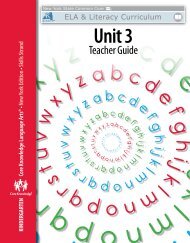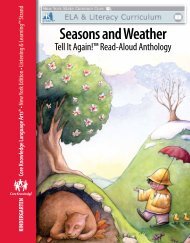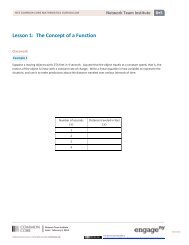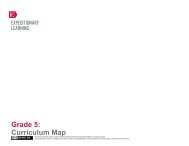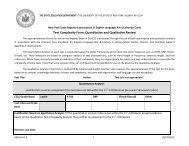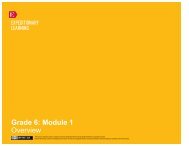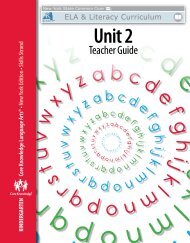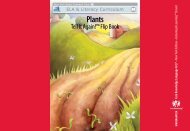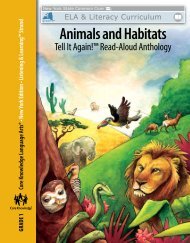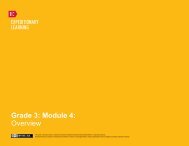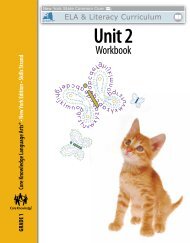Tell It Again! Read-Aloud Anthology - EngageNY
Tell It Again! Read-Aloud Anthology - EngageNY
Tell It Again! Read-Aloud Anthology - EngageNY
Create successful ePaper yourself
Turn your PDF publications into a flip-book with our unique Google optimized e-Paper software.
12 [Show this location on a U.S.<br />
map. You may also wish to show<br />
image 8A-5 again to illustrate this<br />
meeting point.]<br />
13 or low pay<br />
14 or track<br />
15 Drive means to push something<br />
with force. Drive also means to<br />
direct the movement of a vehicle.<br />
May 10, 1869. Promontory Point, Utah 12 —Only one hundred<br />
feet left to lay—that’s what I thought of first thing this<br />
morning. After several years of hard work, long hours, and<br />
little wages, 13 one hundred feet of track is all there is left to<br />
complete the transcontinental railroad today. Now, it is hard to<br />
believe the work is complete. Despite the hardship I endured, I<br />
feel proud of my work. I think everyone today wanted to share<br />
in that sentiment. Wherever I looked, people tried to lend a<br />
hand in finishing the track. Men that were just passing through<br />
Utah to deliver goods stopped to throw dirt on the ties, 14 or<br />
to drive a spike into the ground. 15 Even the presidents of the<br />
Central Pacific Railroad and the Union Pacific Railroad took<br />
turns driving the last spike into the rails. <strong>It</strong> was a spike made of<br />
gold to mark the special occasion. They both missed on their<br />
first try, and all of us workers laughed. <strong>It</strong>’s not as easy as we<br />
made it look. In fact, it was very difficult.<br />
Show image 8A-7: Working through the rugged Sierra Nevada<br />
16 Who was the larger-than-life<br />
character that hammered through<br />
tunnels in a tall tale you heard?<br />
(John Henry)<br />
Day in and day out we swung those heavy hammers, driving<br />
the sharp spikes that held the wooden ties together into the<br />
solid ground. We carried heavy wooden ties in the hottest<br />
weather you can imagine. The worst days, by far, were those<br />
spent drilling tunnels into the Sierra Nevada mountains. 16<br />
These tunnels had to be big enough for locomotive trains to<br />
pass through. First, the stone had to be blasted with dynamite.<br />
Then we went in and worked on shaping the tunnel. No matter<br />
how hard we worked to cut into the stone, we would only<br />
move a few inches a day. I can still remember how tired my<br />
arms felt at the end of those days. <strong>It</strong> seemed like there was<br />
no end in sight, and we’d never reach the other side of the<br />
mountains.<br />
122 Westward Expansion 8A | Working on the Transcontinental Railroad<br />
© 2013 Core Knowledge Foundation



